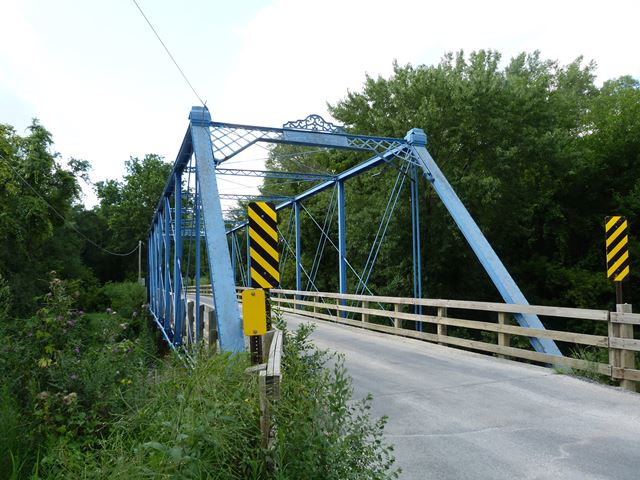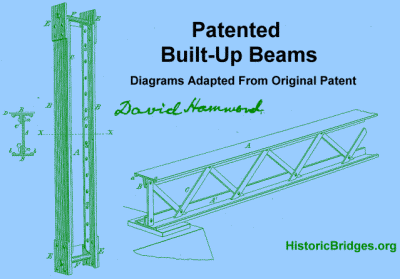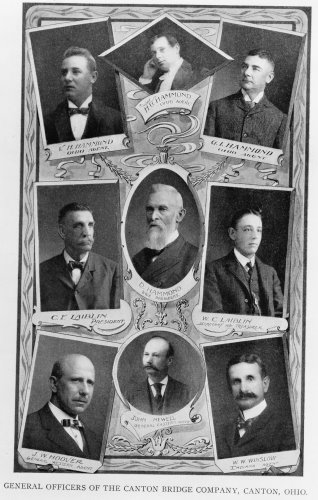We Recommend:
Bach Steel - Experts at historic truss bridge restoration.
BridgeHunter.com Phase 1 is released to the public! - Visit Now
Bertram Road Bridge
Iowa Bridge Number 220850

Primary Photographer(s): Nathan Holth and Rick McOmber
Bridge Documented: July 2, 2009 and August 10, 2013
Near Cedar Rapids: Linn County, Iowa: United States
By Builder/Contractor: Wrought Iron Bridge Company of Canton, Ohio
1987
115.2 Feet (35.1 Meters)
191.0 Feet (58.2 Meters)
15.7 Feet (4.79 Meters)
1 Main Span(s) and 4 Approach Span(s)
220850

View Information About HSR Ratings
Bridge Documentation
This bridge has been relocated. This page and its photos and maps document the former location of the bridge.
Bridge Status: Relocated and shortened (after being dropped in the river by inexperienced contractors!)2023 Update: This historic bridge was to be replaced and relocated and reused for pedestrian use at Indian Creek Nature Center on Otis Road with estimated location of 41.969132, -91.586503. However, Linn County let the contract to Peterson Contractors Inc. (PCI) of Reinbeck, Iowa for a cost of $2,425,608.45. This contractor dropped and destroyed the bridge in their attempt to move the bridge. Rather than hold the contractor responsible as they should (this is totally inexcusable as companies like Bach Steel can move a bridge without causing a collapse), the county took no action. The bridge was still moved as planned, but is now shorter, and likely has some losses of historic integrity. https://www.kcrg.com/2023/10/20/historic-bertram-road-bridge-finds-new-home-indian-creek-nature-center/
View Archived National Bridge Inventory Report - Has Additional Details and Evaluation

View The Original Patent For The Design of This Bridge
View The Original Patent For The Beams Used On This Bridge's Sway Bracing
View The Original Patent For The Beams Used On This Bridge's Vertical Members
The Bertram Road Bridge is a structure that consists of a single eight panel pin-connected truss span and also includes a series of short wood stringer spans. The truss span's deck consists of wooden deck stringers with a wooden plank deck and an asphalt wearing surface. The substructure of the bridge includes stone piers and abutments. The builder of the Bertram Road Bridge was the Wrought Iron Bridge Company of Canton, Ohio. Wrought Iron Bridge Company grew to become the largest pre-1900 bridge builder in the country, initially making their name by building bowstring truss bridges, but then leading the way in the transition to pin-connected trapezoidal truss bridges. At the turn of the 20th Century they were absorbed into the American Bridge Company. Pictured is an advertisement for the Wrought Iron Bridge Company in 1893. The ad appeared in a magazine called "Paving and Municipal Engineering."
The Bertram Road Bridge is an extremely rare surviving example of a hybrid truss that combines the Whipple and Pratt truss configuration. The main diagonals follow the Pratt configuration, with the counters following the Whipple configuration. This truss design was part of an 1876 patent filed by Wrought Iron Bridge Company owner David Hammond. The company built many truss bridges that list this patent on them, but most of them do not actually follow the hybrid truss configuration displayed in the original patent file, and instead display either a true Whipple or Pratt. The Bertram Road Bridge is one of the only known surviving examples of a Wrought Iron Bridge Company following the true hybrid design, making the bridge both rare and historically significant.
As previously mentioned, the hybrid truss design seen here is extremely rare. Interestingly however, one other example has been found, and it is the Whites Ridge Road Bridge. What is really strange however is that the Whites Ridge Road Bridge was built by one of the main competitors of Wrought Iron Bridge Company: Massillon Bridge Company. Massillon bridge Company was another extremely prolific bridge builder and interestingly the company's Massillon, Ohio location placed it right next to Wrought Iron Bridge Company's base of operations in neighboring Canton, Ohio. It remains unclear if the Whites Ridge Road Bridge was a attempt to copy the Wrought Iron Bridge Company Bridge patent, nor if is clear if any conflicts may have resulted between the company's. Either way, neither company appears to have used the odd hybrid truss configuration extensively or beyond the 1870s.
At the same time David Hammond filed a patent for the truss bridge and configuration, he also filed two additional patents for three types of built-up beams. The Bertram Road Bridge closely displays the patented built-up i-beam vertical members as outlined in the patent. In addition, the Bertram Road Bridge has sway bracing that uses patented v-laced beams with rolled "T" beams on top and paired angles on the bottom.
The general designs of the beams (such as using pairs of angles and v-lacing to form a beam) would by the 1880s be copied widely by other bridge companies, who would work on figuring out ways to make subtle changes to their own designs so as not to be in technical violation of patent. However, some of the subtle aspects of the claims in the patents would remain under the stewardship of Wrought Iron Bridge Company. For example, a key part of the patent that never widely caught on with other bridge companies was the use of rolled "T" beams to compose built-up beams. Instead, most companies just stuck with pairs of rolled angles to form a "T" rather than using a single rolled "T".
The Bertram Road bridge has another unusual detail which is the hip verticals which are made of star iron, which is also called cruciform beams. These beams were commonly used on bowstring truss bridges built in the 1870s, but their use on other truss forms is rare.
Other significant features that are common to the earliest Wrought Iron Bridge Company trapezoidal truss bridges (and thus generally rare) include the cast iron caps that cover the uncommon bolted diagonal connection detail at the top chord / end post intersection point. These caps and connection detail are not part of the 1876 patent, but were used by the company on a number of their early bridges. Two of these caps are missing from the bridge. Cast iron guides with assembly numbers are present at the verticals where they intersect with the counters. The ornate "crown" remains mounted on top of the portal bracing right above the typical period Wrought Iron Bridge Company plaque mounted on the portal bracing. One of the plaques is missing. Finally also present on the bridge are Wrought Iron Bridge Company's unusual cast iron bearing plates and shoe assembly (with roller bearing nest between) with the unusual bolted connection for the bottom chord.
The construction date of this bridge is not known. Wrought Iron Bridge Company was notorious for posting patent dates on its plaques but not posting construction dates. Because of the arcane design of the truss and the use of star iron (cruciform beams) it is reasonable to assume this is a very early example built soon after the patent date. It is safe to assume this bridge was constructed between 1876 and 1880.
Given the fairly extensive discussion given to the history and nature of the Wrought Iron Bridge Company on this page, readers might also be interested to view a copy of a set of proposals, plans, and specifications for a truss bridge proposed by the Wrought Iron Bridge Company. The proposal is not for the Bertram Road Bridge, but instead a bridge in Cumberland County, Pennsylvania. However, the proposal is likely similar to what the company would have submitted to the county for the Bertram Road Bridge. The proposal was provided in digitized format by Cumberland County, Pennsylvania. View it in PDF format here. Also, click here to view a PDF that contains two excerpts from the Historic American Engineering Record for two unrelated bridges. These excerpts include a detailed history of the Wrought Iron Bridge Company, as well as a discussion of the "bridge pools" that existed (and which Wrought Iron Bridge Company was a part) where different companies worked together to trick counties and townships into paying more for their bridges than needed.
Aside from the aforementioned missing plaque and two cast iron caps, the bridge retains excellent historic integrity with the only other apparent alteration being the addition of modern bolts to part of the top chord. The structural condition of the bridge appears to be good and the bridge appears to have been maintained. Future preservation work may have to include addressing the loss of the final layer of paint in sections of the bridge, although the primer appears to be currently holding on the bridge, so rust is not yet forming extensively on the bridge.
The current blue paint color on the bridge is attractive and should be maintained. Far too often preservation projects select a dark paint color that hides the beautiful and intricate truss details. The blue color present on this bridge is not overwhelming but at the same time it draws attention to the intricacies of the truss.
The Bertram Road Bridge is an extremely important example of a bridge built by the most prolific pre-1900 bridge company in the country, that closely follows claims specified in several filed patents. The bridge is representative of the spirit of experimentation that dominated metal bridge construction from the 1850s through the 1870s.
Information and Findings From Iowa's Historic Bridge InventoryDiscussion of Bridge This short-span through truss extends northwest-southwest across a stream in southern Linn County on Bertram Road about a mile east of Cedar Rapids. A plate located on the bridge's south portal notes that the Wrought Iron Bridge Company (WIBCo) erected the structure, using a design that it had patented in 1876. This bridge was presumably constructed shortly after the patent had been issued. WIBCo's patented design was a variation of a standard Pratt truss configuration, employing double-intersecting counter members radiating outward from the center of the span. WIBCo used this unusual Whipple truss configuration on another Linn County bridge, the Upper Paris Bridge, which it constructed in 1879, and on other bridges in the state. The Wrought Iron Bridge Company was established in 1864 and was ultimately absorbed into the American Bridge Company in 1900. It was one of several Ohio companies that provided many of Iowa's that provided many of Iowa's early metal bridges. This early wrought-iron truss features four timber stringer spans at its north approach and is supported by a combination stone/timber substructure. With no alterations of note, the bridge continues to carry intermittent vehicular traffic. In its extensive dealings with the Wrought Iron Bridge Company in the 1870s, Linn County was simply following a regional trend. In the 1870s, Wrought Iron was one of the largest fabricators in America; its president, David Hammond, distinguished himself as one of the country's most prolific bridge innovators. The period of extensive rural road and bridge construction in the state during the 1870s coincided with the firm's ascendance in the industry, combining to create a booming market for WIBCo's regional sales representatives. The Ohio giant was extremely active in the region at this time. By 1885 WIBCo had installed 21,600 feet of bridges in Iowa, almost equaling the total output of WIBCo across America in its first nine years of business. That year WIBCo's bridges could be found in 41 of the state's 99 counties. The Indian Creek Bridge typifies WIBCo's penchant for the esoteric. Although the company marketed bowstrings and single-intersection Pratt trusses extensively, it also experimented with other forms, such as this double-intersection Pratt. The Indian Creek Bridge is significant as a well-preserved example of an uncommon early wagon truss configuration, built by what was perhaps the most influential bridge building in Iowa in the 1870s [adapted from Roise, Hess, and Crow-Dolby 1992]. Bridge Considered Historic By Survey: Yes |
![]()
Photo Galleries and Videos: Bertram Road Bridge
Bridge Photo-Documentation
Original / Full Size PhotosA collection of overview and detail photos. This gallery offers photos in the highest available resolution and file size in a touch-friendly popup viewer.
Alternatively, Browse Without Using Viewer
![]()
Bridge Photo-Documentation
Mobile Optimized PhotosA collection of overview and detail photos. This gallery features data-friendly, fast-loading photos in a touch-friendly popup viewer.
Alternatively, Browse Without Using Viewer
![]()
Maps and Links: Bertram Road Bridge
This historic bridge has been relocated and is no longer at this location. See the main bridge page for a link to the new bridge location. This map is shown for reference purposes only.
Coordinates (Latitude, Longitude):
Search For Additional Bridge Listings:
Bridgehunter.com: View listed bridges within 0.5 miles (0.8 kilometers) of this bridge.
Bridgehunter.com: View listed bridges within 10 miles (16 kilometers) of this bridge.
Additional Maps:
Google Streetview (If Available)
GeoHack (Additional Links and Coordinates)
Apple Maps (Via DuckDuckGo Search)
Apple Maps (Apple devices only)
Android: Open Location In Your Map or GPS App
Flickr Gallery (Find Nearby Photos)
Wikimedia Commons (Find Nearby Photos)
Directions Via Sygic For Android
Directions Via Sygic For iOS and Android Dolphin Browser
USGS National Map (United States Only)
Historical USGS Topo Maps (United States Only)
Historic Aerials (United States Only)
CalTopo Maps (United States Only)







